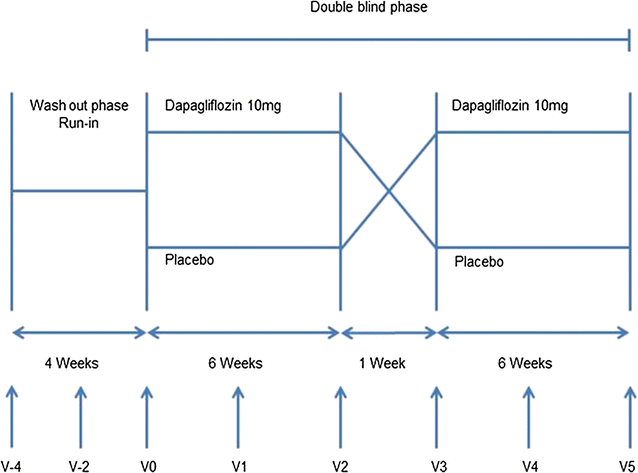A randomised study of the impact of the SGLT2 inhibitor dapagliflozin on microvascular and macrovascular circulation
- PMID: 28231831
- PMCID: PMC5324272
- DOI: 10.1186/s12933-017-0510-1
A randomised study of the impact of the SGLT2 inhibitor dapagliflozin on microvascular and macrovascular circulation
Abstract
Background: The sodium-glucose cotransporter 2 inhibitor, dapagliflozin, has been shown to improve diabetic control and reduce blood pressure in patients with type 2 diabetes mellitus. Its effects on micro- and macrovascular structure and function have not yet been reported.
Methods: This was a prospective, single-centre, placebo-controlled, double-blind, randomised crossover phase IIIb study conducted between March 2014 and February 2015. After a 4-week run-in/washout phase, patients (N = 59) received 6 weeks of either dapagliflozin 10 mg or placebo once daily. They then underwent a 1-week washout before crossing over to the other treatment. Changes in retinal capillary flow (RCF) and arteriole remodelling were evaluated using scanning laser Doppler flowmetry, while micro- and macrovascular parameters in the systemic circulation were assessed using pulse wave analysis.
Results: Six weeks of dapagliflozin treatment resulted in improvements in diabetes control, including blood glucose and insulin resistance, and reduced office and 24-h ambulatory blood pressure values. RCF decreased from 324 AU at baseline to 308 AU after treatment with dapagliflozin (p = 0.028), while there was little difference after the placebo (318 AU; p = 0.334). Furthermore, the arteriole remodelling that was seen after the placebo phase was not evident after the dapagliflozin phase. Central systolic and diastolic blood pressure values were significantly lower after 6 weeks of dapagliflozin, by 3.0 and 2.2 mmHg, respectively (p = 0.035 and 0.020, respectively vs. baseline).
Conclusions: Six weeks of dapagliflozin treatment resulted in numerous beneficial effects. In addition to achieving superior diabetes control and blood pressure, parameters associated with the early stages of vascular remodelling were also improved. Trial registration http://www.clinicaltrials.gov (NCT02383238).
Keywords: Arterial remodelling; Blood pressure; Insulin resistance; Pulse wave analysis; SGLT2 inhibitors; Scanning laser Doppler flowmetry, vascular protection.
Figures
Similar articles
-
SGLT-2-inhibition with dapagliflozin reduces tissue sodium content: a randomised controlled trial.Cardiovasc Diabetol. 2018 Jan 4;17(1):5. doi: 10.1186/s12933-017-0654-z. Cardiovasc Diabetol. 2018. PMID: 29301520 Free PMC article. Clinical Trial.
-
Blood pressure and glycaemic effects of dapagliflozin versus placebo in patients with type 2 diabetes on combination antihypertensive therapy: a randomised, double-blind, placebo-controlled, phase 3 study.Lancet Diabetes Endocrinol. 2016 Mar;4(3):211-220. doi: 10.1016/S2213-8587(15)00417-9. Epub 2015 Nov 27. Lancet Diabetes Endocrinol. 2016. PMID: 26620248 Clinical Trial.
-
How does empagliflozin improve arterial stiffness in patients with type 2 diabetes mellitus? Sub analysis of a clinical trial.Cardiovasc Diabetol. 2019 Mar 29;18(1):44. doi: 10.1186/s12933-019-0839-8. Cardiovasc Diabetol. 2019. PMID: 30922297 Free PMC article. Clinical Trial.
-
Impact of sodium-glucose cotransporter 2 inhibitors on blood pressure.Vasc Health Risk Manag. 2016 Oct 27;12:393-405. doi: 10.2147/VHRM.S111991. eCollection 2016. Vasc Health Risk Manag. 2016. PMID: 27822054 Free PMC article. Review.
-
Sodium glucose co-transporter 2 inhibitors and their mechanism for improving glycemia in patients with type 2 diabetes.Postgrad Med. 2014 Oct;126(6):33-48. doi: 10.3810/pgm.2014.10.2819. Postgrad Med. 2014. PMID: 25414933 Review.
Cited by
-
Evidence-Based Consensus on Positioning of SGLT2i in Type 2 Diabetes Mellitus in Indians.Diabetes Ther. 2019 Apr;10(2):393-428. doi: 10.1007/s13300-019-0562-1. Epub 2019 Jan 31. Diabetes Ther. 2019. PMID: 30706366 Free PMC article. Review.
-
SGLT2 inhibition with empagliflozin attenuates myocardial oxidative stress and fibrosis in diabetic mice heart.Cardiovasc Diabetol. 2019 Feb 2;18(1):15. doi: 10.1186/s12933-019-0816-2. Cardiovasc Diabetol. 2019. PMID: 30710997 Free PMC article.
-
Effect of SGLT2 Inhibitors on the Sympathetic Nervous System and Blood Pressure.Curr Cardiol Rep. 2019 Jun 21;21(8):70. doi: 10.1007/s11886-019-1165-1. Curr Cardiol Rep. 2019. PMID: 31227915 Review.
-
Impact of SGLT2 Inhibitors on Heart Failure: From Pathophysiology to Clinical Effects.Int J Mol Sci. 2021 May 30;22(11):5863. doi: 10.3390/ijms22115863. Int J Mol Sci. 2021. PMID: 34070765 Free PMC article. Review.
-
The Comparison of the Effectiveness of Dapagliflozin and Empagliflozin in the Prevention of Cardiovascular Outcomes in Patients With Type 2 Diabetes: A Network Meta-Analysis.Cureus. 2024 Sep 19;16(9):e69711. doi: 10.7759/cureus.69711. eCollection 2024 Sep. Cureus. 2024. PMID: 39429324 Free PMC article. Review.
References
-
- Ryden L, Grant PJ, Anker SD, Berne C, Cosentino F, Danchin N, Deaton C, Escaned J, Hammes HP, Huikuri H, et al. ESC guidelines on diabetes, pre-diabetes, and cardiovascular diseases developed in collaboration with the EASD: the task force on diabetes, pre-diabetes, and cardiovascular diseases of the European Society of Cardiology (ESC) and developed in collaboration with the European Association for the Study of Diabetes (EASD) Eur Heart J. 2013;34:3035–3087. doi: 10.1093/eurheartj/eht108. - DOI - PubMed
-
- Forst T, Weber MM, Mitry M, Schondorf T, Forst S, Tanis M, Pfutzner A, Michelson G. Pilot study for the evaluation of morphological and functional changes in retinal blood flow in patients with insulin resistance and/or type 2 diabetes mellitus. J Diabetes Sci Technol. 2012;6(1):163–168. doi: 10.1177/193229681200600120. - DOI - PMC - PubMed
-
- Harazny JM, Raff U, Welzenbach J, Ott C, Ritt M, Lehmann M, Michelson G, Schmieder RE. New software analyses increase the reliability of measurements of retinal arterioles morphology by scanning laser Doppler flowmetry in humans. J Hypertens. 2011;29(4):777–782. doi: 10.1097/HJH.0b013e328343c27a. - DOI - PubMed
Publication types
MeSH terms
Substances
Associated data
LinkOut - more resources
Full Text Sources
Other Literature Sources
Medical


